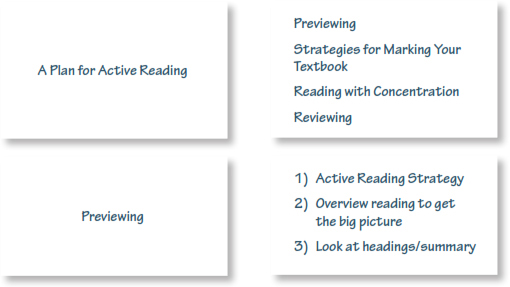Previewing
YOUR TURN
Work Together
Working with a group of your classmates, discuss which of these four steps you always, sometimes, or never do. Which steps do your classmates think are necessary, if any, and why?
The purpose of previewing is to get the big picture, that is, to understand how what you are about to read connects with what you already know and to the material the instructor covers in class. Begin by reading the title of the chapter. Ask yourself: What do I already know about this subject? Next, quickly read through the introductory paragraphs. Then read the summary at the beginning or end of the chapter if there is one. Finally, take a few minutes to skim the chapter, looking at the headings and subheadings. Note any study exercises at the end of the chapter.
As part of your preview, note how many pages the chapter contains. It’s a good idea to decide in advance how many pages you can reasonably expect to cover in your first study period. This can help build your concentration as you work toward your goal of reading a specific number of pages. Before long, you’ll know how many pages are practical for you.
Keep in mind that different types of textbooks can require more or less time to read. For example, depending on your interests and previous knowledge, you might be able to read a psychology text more quickly than a logic text that presents a whole new symbol system.
mapping A preview strategy of drawing a wheel or branching structure to show relationships between main ideas and secondary ideas and how different concepts and terms fit together and help you make connections to what you already know about the subject.
Mapping. The process of mapping the chapter as you preview it provides a visual guide for how different chapter ideas fit together. Because many students identify themselves as visual learners, visual mapping is an excellent learning tool for test preparation as well as reading (see Chapter 4, How You Learn). To map a chapter, use either a wheel structure or a branching structure as you preview the chapter (see Figure 6.1). In the wheel map, place the central idea of the chapter in the circle. The central idea should be in the introduction to the chapter and might be apparent in the chapter title. Place secondary ideas on the spokes emanating from the circle and place offshoots of those ideas on the lines attached to the spokes. In the branching map the main idea goes at the top, followed by supporting ideas on the second tier and so forth. Fill in the title first. Then, as you skim the chapter, use the headings and subheadings to fill in the key ideas.

Alternatives to Mapping. Perhaps you prefer a more linear visual image. If so, consider making an outline of the headings and subheadings in the chapter. You can fill in the outline after you read. Alternatively, make a list. A list can be particularly effective when you are dealing with a text that introduces many new terms and their definitions. Set up the list with the terms in the left column and fill in definitions, descriptions, and examples on the right after you read. Divide the terms on your list into groups of five, seven, or nine, and leave white space between the clusters so that you can visualize each group in your mind. This practice is known as chunking. Research indicates that we learn material best when it is in chunks of five, seven, or nine.
chunking A previewing method that involves making a list of terms and definitions from the reading and then dividing the terms into smaller clusters of five, seven, or nine to learn the material more effectively.
If you are an interactive learner, make lists or create a flash card for each heading and subheading (see Figure 6.2). Then fill in the back of each card after reading each section in the text. Use the lists or flash cards to review with a partner or recite the material to yourself.

Previewing, combined with mapping, outlining, or flash cards, might require more time up front, but it will save you time later because you will have created an excellent review tool for quizzes and tests. You will be using your visual learning skills as you create advanced organizers to help you associate details of the chapter with the larger ideas. Such associations will come in handy later on. As you preview the text material, look for connections between the text and the related lecture material. Call to mind the related terms and concepts that you recorded in the lecture. Use these strategies to warm up. Ask yourself: Why am I reading this material? What do I want to know?